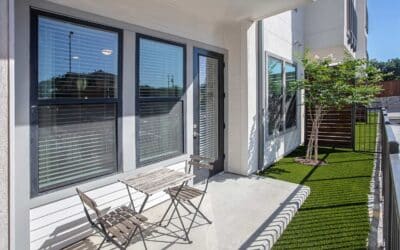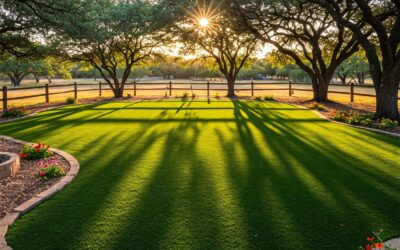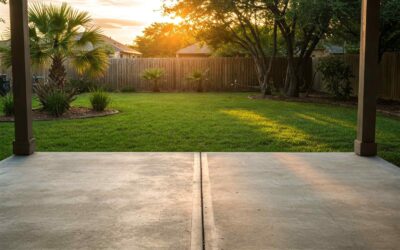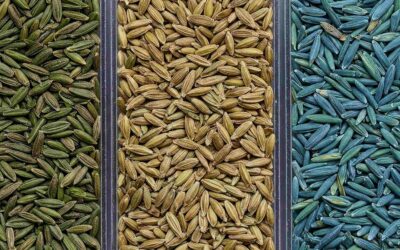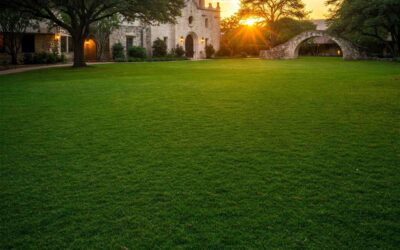Artificial grass stays green and immaculate and keeps its curb appeal all year round without you having to break your back on maintenance. It also helps to lower the cost of ownership of a backyard lawn.
However, one of the drawbacks of making the switch from natural grass for some homeowners is the concern that synthetic grass gets hot, especially in the hotter parts of the country in the summer months. Some homeowners even believe that their grass could melt in the sun or burn their feet.
Are these valid concerns?
Artificial grass is certainly hotter than real grass but it shouldn’t be a “deal breaker” for anyone, even in the sunniest and hottest areas, if you choose the right grass and do the right things.
Here’s what you need to know about artificial grass and keeping it cool in the heat of the summer months…
Does Artificial Grass Get Hot?

Like with all synthetic fibers, artificial grass does heat up when exposed to direct sunlight. It gets hotter than real grass—but turf has come a long way since the early days of AstroTurf. It’s not only more realistic but it stays cooler too.
Cooling technology employed during the manufacturing process ensures that the heat is manageable and your family can use the turf area all year round.
Some types of artificial grass are better at deflecting heat than others and be aware that many of the studies about how hot artificial grass gets were conducted many years ago.
For instance, a University of Maryland study from 2010 tested the temperature of neighboring Bermuda grass, artificial grass, and parking lots on a day when the mercury hit 100F. The study found that the natural grass reached 94F, the artificial grass reached 157F, and the parking lot 140F.
The following statistics are from even earlier, in a 2002 study from Bingham Young University:

Other reports use studies from the early 1990s when artificial turf was very different from the turf produced three decades later.
Many studies were also conducted on professional sports fields, which often used crumb rubber as an infill amid concerns for player safety. Crumb rubber absorbs impact but also heat and, therefore, gets hotter than most backyard infills used today (see more about this below).

Nowadays, many NFL stadiums and famous college football stadiums in hot areas of the country use artificial grass instead of real grass for playing fields, including the AT&T Stadium in Dallas, the UT Stadium in Austin, and the Mercedes Benz Stadium in Atlanta.
This points to the fact that modern, high-quality turf fares much better in the heat than its earlier versions.
The synthetic grass installed by Artificial Grass Pros is designed to withstand the high temperatures and sunny climate of the southern states and is a far cry from the hot green “rug” from decades ago.

So, it’s fair to say that artificial grass does get hotter than real grass but not dangerously so even on the hottest days—and other landscaping materials used in the yard like decking, pavers, gravel, and asphalt will pose more of a threat to sensitive feet on the hottest, sunniest days than our artificial grass.
It’s also fair to say that on the hottest days of summer, it’s usually too hot to be sitting outside in direct sunlight anyway—so it’s unlikely you’ll be walking barefoot on the hottest temperatures that artificial grass can reach.
If you have a backyard swimming pool, you can protect the surrounding areas with shade. After all, hot sand doesn’t deter people from going to the beach on sunny days, does it?!!!
Why Is Artificial Grass Hotter Than Real Grass?
Real grass has a natural ability to absorb water, helping it to stay cooler than synthetic grass—but much depends on the makeup of the artificial grass in question.
For starters, the synthetic fibers in artificial grass are made from one of three main materials:
- Polypropylene
- Polyurethane
- Nylon
These synthetic materials alone have different properties but all synthetic materials of this type heat up more than natural grass.
We must also consider other factors when assessing why turf becomes hot: the color, blade shape, density, and face weight of the grass you choose, as well as the infill type you use, will affect how well the artificial grass deflects heat.

How Does The Color Affect The Temperature Of Artificial Grass?
Dark-colored artificial grass tends to absorb more heat and become hotter under direct sunlight than lighter-colored turf.
If you’re concerned about the midday heat, it’s best to opt for a lighter shade of artificial grass, all other factors being equal.

How Does The Blade Shape Affect The Temperature Of Turf?
Surprisingly for some homeowners, the blade shape of artificial turf affects its heat-absorbing/cooling qualities.
It’s best to choose a blade shape that is not flat and wide as this can prevent adequate airflow and increase the absorption of heat. Three-dimensional, hollow blade shapes aid the cooling of the area.

How Does Density Affect The Temperature Of Artificial Turf?
Artificial turf with compact and curled fibers retains more heat than turf with straighter, less compacted fibers.
A good example is putting green turf, which is usually more dense and compacted than lawn turf, despite being relatively lightweight normally. This turf tends to get hotter than other types of turf because of the extra density.

How Does Face Weight Affect The Temperature Of Synthetic Grass?
The face weight of artificial turf is the weight of the synthetic fibers excluding the backing. Most heavyweight artificial grasses tend to heat up more in the sun though that’s not always the case (see the previous example of putting green turf).
If your turf is lightweight, light in color, and not too compacted, it will generally have a better chance of staying cooler than darker, heavyweight, compacted turf of comparable quality. But there’s another important factor to consider…
How Does The Infill Affect The Temperature Of Artificial Grass?
In addition to the materials discussed, infill is added to the grass surface for a more realistic appearance, as well as to prevent bumps or wrinkles from forming and ensure proper drainage.
Infill is a granular, bead-like material that is spread between the turf fibers evenly after installation, helping to keep turf fibers upright and look more natural. It will also affect how hot the turf area gets.
Infill material is usually silica-based or made of crumb rubber but quartz, various plastics or even coconut shells may also be used.
If you’re concerned about the heat, avoid crumb rubber infill, which absorbs heat and causes the area to heat up.

What Is CoolFlo Technology?
Ultimately, the makeup of your artificial turf’s fibers, backing, and infill and its color will affect how much heat it absorbs and radiates, especially when the sun is shining.
Technological advances have addressed these factors in the past decade, significantly improving the ability of the best artificial grass to stay cool (as well as retain its vibrant color) even during the hottest and sunniest days
The CoolFlo technology employed in the manufacture of our artificial turf ensures a three-dimensional, hollow yarn shape that increases airflow and lowers surface temperature by 10 to 20 percent, as well as providing enhanced light deflection and sheen/shine reduction. This has been tested in controlled lab environments as well as in situ on many artificial turf spaces across the country.
This manufacturing technique also adds to the realistic appearance of the turf and improves its overall strength and durability. The yarn we use is also stabilized to resist fading from the sun, so the turf keeps its color in the sunlight and its anti-acid properties make it resistant to chemical attack.
Advanced turf design and manufacture such as this is a far cry from past artificial grass offerings and is a big reason why more home and business owners are making the switch from real grass.

Can Artificial Grass Melt In The Sun?
If your artificial grass starts to melt in the sun, you’re doing something wrong. In well over 5,000 installations across the American South, our team has never heard a home or business owner complain that their grass has melted.
The melting points of polyethylene, polyurethane, and nylon are in the region of 180-300 degrees Fahrenheit so if synthetic turf melts, something else is behind it apart from the sunshine and climatic heat.
Typically, this problem is due to one of the following:
- Reflected sunlight from the home’s windows
- Reflections from other shiny surfaces around the yard
- Direct heat/naked flame

With correct installation and a few simple homeowner precautions, there should be no concerns over melting artificial grass.
How Can You Keep Your Artificial Grass Cool In Summer?
You can’t stop the sun beating down and raising the temperature of your artificial grass but many factors are within your control.
Most homeowners want to use their artificial lawn all year—that’s one of the attractions of artificial turf. The good news is that this should be possible even in the hottest days of summer and it’s rare that any grass installed by our team will heat up enough to be uncomfortable to use.

Here’s what you need to do:
Select High-Quality Artificial Grass With Cooling Technology
You can buy artificial grass at Walmart, Amazon or elsewhere. Very little of this will be of the same standard as the top-grade, American-made artificial grass that we install at Artificial Grass Pros.
The best artificial grass is engineered to remain cooler than most of the cheaper brands because it employs advanced cooling technology that reflects the sun and can keep the surface 10-20 percent cooler than inferior grass.
High-quality turf also lasts longer and looks more natural than then cheaper stuff, as well as providing other benefits. Investing in quality will generally pay long-term dividends.

Get Your Turf Installed Professionally
Most potential problems with artificial grass can be at least partially resolved with an installation team that knows what it’s doing.
A professional installation team from Artificial Grass Pros will prepare the ground beneath the turf properly, ensuring adequate drainage and airflow, which will help prevent heat buildup. We can also advise you on avoiding glare from windows and any other potential hazards that can overheat artificial grass.
Glare issues can be fixed by installing anti-reflective film on problematic windows.

Select The Right Infill (No Crumb Rubber)
Infills are available in many forms, as explained above. To help your artificial grass stay cool, avoid crumb rubber.
Crumb rubber is often used on artificial sports fields because of its ability to absorb impact and prevent injury but it is renowned for also absorbing heat. For standard lawns, dog runs, swimming pool turf, etc., crumb rubber infill is neither recommended nor necessary. Silica-based infill is a far better solution and will remain cooler.
You can also consider a specialized cooling infill, like HydroChill or T°Cool, which requires you to wet down your lawn with the hose or sprinkler to activate the cooling properties effectively.
If you have dogs, it’s important to use an antimicrobial infill to help disperse odors and maintain a comfortable surface temperature.

If in doubt, the turf professionals at Artificial Grass Pros can advise you on infill.
Create Plenty Of Shaded Areas
Naturally shaded areas provided by trees and shrubs can be supplemented by shaded sitting areas or other backyard landscaping ideas. You and your family can enjoy the summer weather without worrying about overheating.
It will take time to feel the benefits of planting trees but canopies, awnings, shade sails or other types of artificial shade will keep the sun off your lawn area while also adding a decorative design element to your yard.

Spray Water On Your Turf During The Hottest Months
A quick way to reduce the surface temperature of your artificial grass is to spray it with water from the garden hose.
One of the main benefits of artificial grass is that constant watering isn’t needed to keep it looking green and healthy but an occasional spray on hot days is a great way to keep the area clean and hygienic as well as cool.

Maintain Your Turf To Prevent Compaction
Artificial turf is low maintenance compared to real grass but cross-brushing the area from time to time will help the grass blades stand upright, prevent compaction, and allow it to “breathe” and release heat more effectively.
Cross-brushing involves brushing the area “against the grain” with a stiff-bristled brush (but not metal).

Invest In Specialist Artificial Grass Cooling Technology
The most advanced cooling systems for artificial turf keep your lawn cool even during the hottest summer days but are expensive and must be installed before the artificial turf is laid.
These systems use cooling liquid that circulates among the synthetic turf, preventing it from overheating in the sun.
FAQs
Is Artificial Grass Too Hot For Dogs?
No, artificial grass has far more pros than cons if you have dogs and won’t get too hot for them or other pets. It is safe and requires much less maintenance than real grass. Choose a high-quality pet turf and take a few simple precautions during installation and your dogs will love artificial grass as much as you do.
Do All Types Of Artificial Turf Get Hotter Than Grass?
All types of synthetic turf will get hotter than regular grass but not all are made the same. Cooling technology helps some turf products deflect heat and maintain better airflow than others.

Customized Artificial Grass That Stays Cool…
Modern, high-quality artificial grass that is professionally installed requires minimal maintenance and stays like new for longer. It also remains cooler than the traditional AstroTurf-type grass from decades ago because of the advanced technology used during the manufacturing process and more infill options.
On the hottest days in the middle of summer, your artificial turf area can be kept cool by watering it but longer term you may want to look into landscaping a few more shaded areas,Our experienced team of turf professionals has helped homeowners enjoy customized backyard lawns that remain cool enough to use all year round. If you’re considering the switch to turf, discuss your options with an artificial grass professional.

